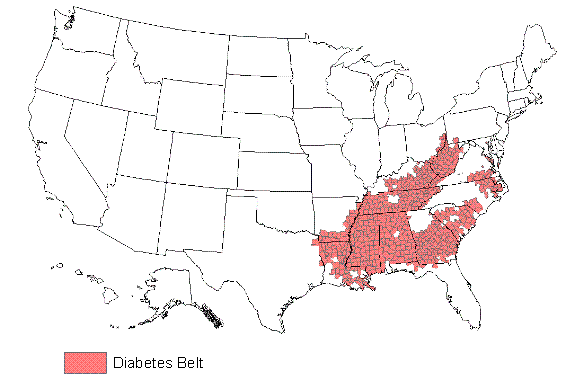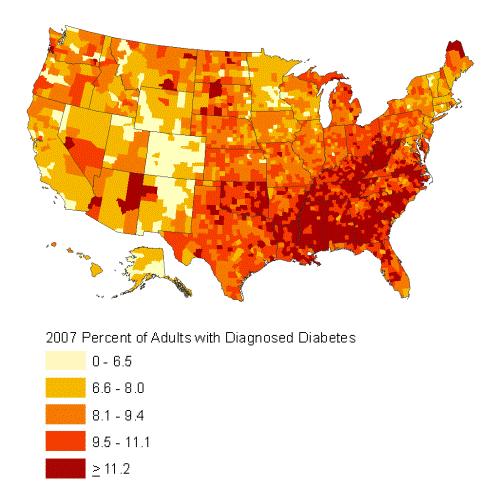CDC Identifies Diabetes Belt
CDC scientists have identified a diabetes belt located mostly in the southern portion of the United States.1 The diabetes belt consists of 644 counties in 15 states.
People who live in the diabetes belt are more likely to have type 2 diabetes than people who live in other parts of the United States. People who do not already have diabetes can reduce their risk by being physically active and, if they are overweight, losing weight. Obesity and inactivity account for nearly a third of the increased risk for type 2 diabetes that scientists noticed in people living in the diabetes belt.

Some other factors for the increased risk can’t be changed, such as age, race and education. People in the diabetes belt are more likely to be African American, and African Americans are at higher risk for type 2 diabetes. People living in the diabetes belt also are less likely to have a college degree. Lower education levels are associated with increased risk for type 2 diabetes.
The diabetes belt has higher rates of obesity and physical inactivity than other U.S. regions. If these rates are reduced, CDC scientists expect that eventually the difference in diabetes rates also would be reduced.
The diabetes belt was identified by counties, rather than states, so that community leaders can identify areas most in need of efforts to prevent new cases of type 2 diabetes.
Community design can encourage healthy lifestyle choices by making it easier to be active physically and find nutritious food. An example is sidewalks, which may promote walking rather than driving.
Counties were placed in the diabetes belt if at least 11% of residents had been diagnosed with diabetes, and if the counties were near each other in the Southeast, which has the highest rates of diabetes, or adjoining areas with high rates of diabetes. There were some counties in other parts of the United States that had diabetes rates of 11% or more, but they are not included in this belt because they are isolated from other counties with high diabetes rates.
Within the diabetes belt, 11.7% of the people have diagnosed diabetes. Outside the belt, 8.5% have diagnosed diabetes.

States with a portion of their counties in the diabetes belt are Alabama, Arkansas, Florida, Georgia, Kentucky, Louisiana, North Carolina, Ohio, Pennsylvania, South Carolina, Tennessee, Texas, Virginia and West Virginia. The entire state of Mississippi is included in the belt.
Data for the study comes from the Behavioral Risk Factor Surveillance System (BRFSS) for 2007 and 2008. BRFSS is an ongoing, state-based, random-digit–dialed telephone survey of the U.S. civilian, non-institutionalized population aged 18 years and older.
The Diabetes Prevention Program research trial, led by the National Institutes of Health, showed that losing 5% to 7% of body weight and getting at least 150 minutes of moderate-intensity exercise each week can reduce the risk of developing type 2 diabetes by nearly 60%. CDC’s National Diabetes Prevention Program is working to make group programs offering similar, evidence-based lifestyle interventions available in communities across the country to help people at high risk for type 2 diabetes. CDC’s role with the National Diabetes Prevention Program includes training the workforce that can implement the program cost effectively and sets standards that will help ensure program quality and consistency.
More Information
County-level estimates of diagnosed diabetes,
leisure-time physical inactivity and obesity
National Diabetes
Education Program
National
Diabetes Prevention Program
Physical Activity
Prevent Diabetes
2008 Physical Activity Guidelines for Americans
National Diabetes
Fact Sheet, 2011
American Journal
of Preventive Medicine
- Lawrence E. Barker, PhD, Karen A. Kirtland, PhD, Edward W. Gregg, PhD, Linda S. Geiss, MA, and Theodore J. Thompson, MS. Geographic distribution of diagnosed diabetes in the United States: a diabetes b. American Journal of Preventive Medicine 2011;40(4).
Contact Us:
- CDC Diabetes Public Inquiries
- 800-CDC-INFO
(800-232-4636)
TTY: (888) 232-6348
8am-8pm ET
Monday-Friday
Closed Holidays - cdcinfo@cdc.gov


